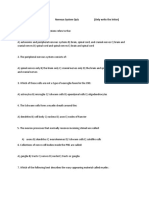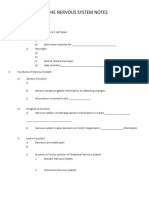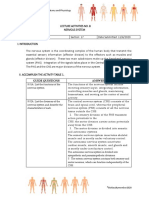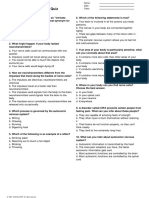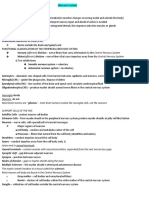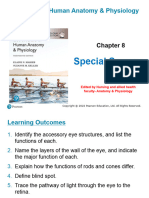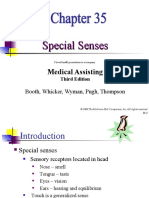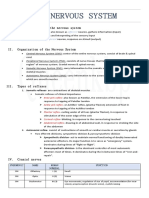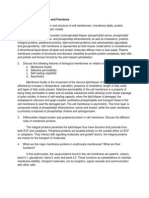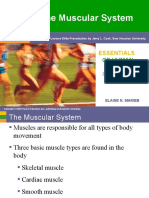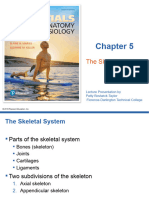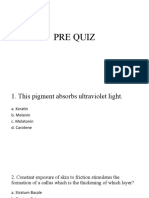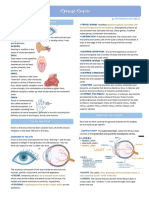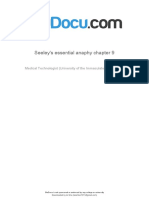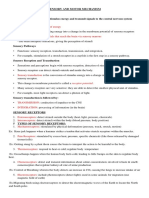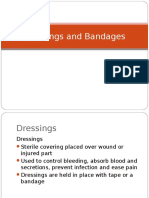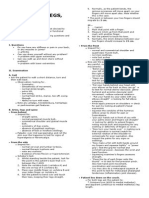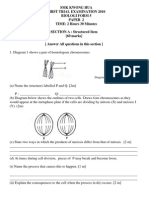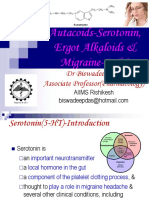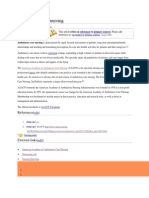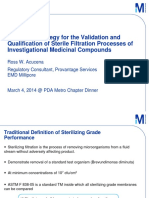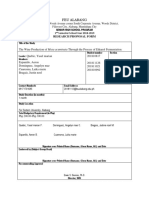Abundant, extends into the axons
and dendrites
- forms a broad, flat, fenestrated
hypolemmal cisterna
- sequester Ca and contain CHONs
and provide
a pathway for their
distribution throughout the cell
NERVOUS SYSTEM
most COMPLEX system in the HUMAN
BODY
formed by a network of >100 MILLION
nerve cells (neurons) assisted by many
more glial cells
CELLS OF NERVOUS SYSTEM
GOLGI COMPLEX
Located only in the cell body
Consists of multiple parallel arrays of
smooth cisternae arranged around the
periphery of the nucleus
Responsible
for
packaging
of
neurotransitter substances
MITOCHONDRIA
Found in soma, dendrites & axon
Most abundant in axon terminals
More slender
Constantly
moving
along
microtubules in the cytoplasm
CENTRIOLE
Characteristic
of
preneuronal
multiplying cells during embryologic
development
only occasionally encountered in
adult neurons
believed to be vestigial structures
(because neurons do not undergo
cell division)
NEURONS
Functional unit of structure of nervous tissue
For receptive, integrative and motor
functions of the nervous system
5 150 um in diameter
NEUROGLIAL CELLS
For supporting and protecting neurons
Do not receive or transmit impulses
PARTS OF A NEURON
1. CELL BODY / PERIKARYON / SOMA
- Central portion which contains the
nucleus & perinuclear cytoplasm
in CNS:
generally polygonal with concave
surfaces between many cell processes
in DRG (sensory ganglion of PNS):
- have a round cell body from which
only 1 process exits
NUCLEUS
Large, spherical to ovoid,
centrally located
Prominent nucleolus
Contains
finely
dispersed
chromatin (may appear vesicular)
Less obvious in smaller neurons
(greater conc. of chromatin)
Sex chromatin of females
prominent
CYTOPLASM
With abundant RER with many
cisternae in parallel arrays
NISSL BODIES
o stacked
RER
cisternae
&
polyribosomes seen as clumps of
basophilic material
o represent sites of protein synthesis
SER
INCLUSIONS
A. Melanin coarse dark-brown/black granules
location:
- certain regions of the CNS (substantia nigra &
locus ceruleus, dorsal motor nucleus of the
vagus & spinal cord)
- sympathetic ganglia of the PNS
- thought to accumulate as by-product of the
synthesis
of
neurotransmitters
dihydrophenylalanine or methyldopa
B. Lipofuscin golden-brown granules
- irregular in shape
- remnants of lysosomal enzymatic
activity
- increase with advancing age, may
even crowd the organelles &
nucleus to one
side possibly affecting cellular function
Purkinje cells of cerebellar cortex
Iron containing pigments
C. Lipid droplet result of faulty metabolism or
normal energy reserves
D. Secretory granules
�- observed in neurosecretory cells
- many contain signaling molecules
CYTOSKELETAL COMPONENTS
microtubules
- 20 28 nm in diameter
- essential role in transport of vesicles &
organelles that move along their
surface
w/in the cell body & along the length of the axon
neurofilaments
- intermediate, 10 nm in diameter
- abundant in perikaryons & cell
processes
microfilaments
- 6 nm in diameter
- composed of 2 strands of polymerized
G-actin arranged in a helix
neurofibrils
- up to 2 um in diameter
- possibly represent clumped bundles of
neurofilaments
2. DENDRITE
- cell body projections
-with abundant mitochondria
- receives stimuli from sensory cells, axons and
other neurons
- impulse received are transmitted towards soma
Dendrite branching pattern permits a
neuron to receive & integrate multiple
impulses
Some have SPINES (permit dendrites to
form synapses with other neurons)
Sometimes contain vesicles & transmit
impulses to other dendrites
3. AXON (axis cylinder)
Varying diameter
Usually very long processes (may be up to
100cm in length)
1 neuron: 1 axon
Conducts impulses away from the soma to
other neurons, muscles or glands
Axolemma - cell membrane
Axoplasm axon cytoplasm
Axon Hillock where axon arises,
absent RER
Collateral branches
Axon Terminal
Nerve Fiber - axon + certain sheaths of
ectodermal origin
SYNAPSE region where impulses can
be transmitted between cells
Functions:
Impulse conduction
Axonal transport
crucial
to
trophic
relationships (within axons
& between neurons &
muscles and glands)
Interruptions lead to atrophy
of target cells
Anterograde transport from cell
body to axon terminal;
MAP :
kinesin
Retrograde transport from axon
terminal to the cell body; MAP :
dynein
Clinical Correlate
Retrograde Axonal Transport
pathway followed by toxins ( e.g.,
tetanus toxin) and neurotropic viruses
(e.g., herpes simplex and rabies) to
penetrate and invade the CNS
Axon : MYELIN SHEATH
MYELIN
Fatlike substance covering axons
concentric layers of mixed lipids
alternating with thin layers of the protein
neurokeratin
associated only with axons
* Unmyelinated Axons
* Myelinated Axon
Produced by Oligodendrocytes (CNS),
Schwann cells (PNS)
Structure of MYELIN SHEATH
Nodes of Ranvier sites of
discontinuity between successive Schwann cells
along the axon
Internodal segments consists of a
singular Schwann cell & its concentric lamellae
of myelin around the axon, delineated by
successive nodes of Ranvier
Incisure of Schmidt-Lantermann
aligned sites of local separation of the myelin
lamellae by residues of cytoplasm trapped in the
spiral
Functions of Myelin Sheats
A. Increases the speed of conduction from
1 m/s in slender unmyelinated axons to
120 m/s in heavily myelinated axons of
large caliber
B. Serves as a high-resistance lowcapacitance insulator
C. Role in nutrition of the axon
�D. Protective role
conductivity
assuring
continuing
MECHANISM OF MYELINATION
Schwann
cell
(or
oligodendrocytes)
concentrically wraps its membrane around the
axon to form the myelin sheath
- wrapping may continue for more than 50 turns
- cytoplasm is squeezed back into the body of
the Schwann cell bringing the cytoplasmic
surfaces of the membranes in contact with each
other forming the major dense line that spirals
through the myelin sheath
PERIPHERAL NERVE SHEATHS
EPINEURIUM
outermost sheath
envelops the nerve & sends extensions
into it to surround the separate nerve
fascicles w/in it
thick & strong investment composed of
dense irregular connective tissue
PERINEURIUM
covers each bundle of nerve fiber
(fascicle)
more dense; consists of a few to several
layers of flattened fibroblast-like cells
bounded both internally & externally by
a basal lamina
barrier to passage of particulate tracers,
dye
molecules/toxins
into
the
endoneurium, thus protecting the
perineural compartment
ENDONEURIUM
surround individual nerve fibers (axons)
delicate, loose connective tissue
consisting of small fibrils of collagen,
fibroblasts,
fixed
macrophages,
capillaries, perivascular mast cells, &
EC fluid
Classification of NEURONS
ACCORDING TO MORPHOLOGY:
BIPOLAR
posses 2 processes emanating from the
soma, a single dendrite and a single
axon
found in the vestibular & cochlear
ganglia & in the olfactory epithelium of
the nasal cavity
PSEUDOUNIPOLAR
when a single process, morphologically
an axon, leaves the body and soon
bifurcates
BRANCHES:
A. peripheral proceeds to its destination
in the body
B. central enters the CNS
present in the dorsal root ganglia & the
ganglia of some cranial nerves
MULTIPOLAR
most common
possess various arrangement of multiple
dendrites emanating from the soma and
a single axon
most are motor neurons
some are named according to
morphology (e.g., Pyramidal cells) or
after the scientist who 1st described
them (e.g., Purkinje cells)
UNIPOLAR
posses only 1 PROCESS emanating
from the cell body
exists in early embryonic life
ACCORDING TO FUNCTION:
A.
SENSORY (AFFERENT) NEURONS
Receives & transmits impulses to
the CNS for processing
B. MOTOR (EFFERENT) NEURONS
Originates in the CNS & transmits
impulses to effector organs throughout
the body
C. INTERNEURONS
located completely in the CNS
function
as
interconnectors
or
integrators that established networks of
neuronal circuits between sensory &
motor neurons and other interneurons
Synapse
Site of transmission of nerve impulses
� Point of contact of a neuron & another
cell
Allows neurons to communicate with
each other or with effector cells (muscle
& gland)
Types of SYNAPSES
A. ELECTRICAL
Uncommon
Few places in the brain stem, retina &
cerebral cortex
Transmission is much more rapid
Transmit impulse through gap junctions
that cross the pre- & postsynaptic
membranes
Ions pass freely through these gap
junctions
B. CHEMICAL
impulse transmission occur mostly
through the release of neurotransmitters
at axon terminal
Components:
A. Presynaptic membrane
B. Synaptic cleft
small
gap
between
that
separates the pre- & postsynaptic membranes
12-20 nm
may contain polysaccharides &
some
fine
intersynaptic
filaments
Postsynaptic membrane
Types of CHEMICAL SYNAPSE
AXONDENDRITIC axon synapses with a
dendrite
AXOSOMATIC axon synapses with a cell body
AXOAXONIC axon synapses with another
axon
DENDRODENDRITIC
SOMATODENDRITIC
SOMATOSOMATIC
SOMATOAXONIC
DENDROAXONIC
AXOAXODENDRITIC
Presynaptic neuron neuron that transmits
the impulse
Postsynaptic cell cell that receives the
impulse (neuron, muscle or gl.)
Bouton expanded portion of the process
that is involved in the formation of a synapse
Synaptic vesicles contain
neurotransmitters, fill the bouton
chemical
NEUROGLIAL CELLS
1. Astrocytes
o largest & most numerous
o star-shaped
&
have
numerous,
branching processes
o involved in metabolic processes
o form scar tissue in damaged areas
o Have bundles of intermediate filaments
made of glial fibrillary acid protein that
reinforce their structure
o Bind neurons to capillaries & to the pia
mater
Types of Astrocytes
A. Protoplasmic
o many
short
branching
processes
o abundant cytoplasm & bigger &
paler-staining nucleus
o found mainly within the gray
matter
B. Fibrous
o with few long processes mostly
unbranched
o closely associated with the pia
mater & blood vessels
o located chiefly in the white matter
o possess euchromatic cytoplasm
containing only a few organelles,
free ribosomes, & glycogen
2. Oligodendrocytes
o smaller, fewer & shorter processes
o scanty
cytoplasm
&
smaller
ovoid/spherical nucleus
o located in the white matter where they
form the myelin sheath
3. Microglia
o Dense elongated nuclei
o small cell with short processes
o cytoplasm scanty & contains many
lysosomes
o phagocytic in nature
o Represent the mononuclear phagocytic
system in nervous tissue & derived from
precursor cells in the bone marrow
o Involved with inflammation & repair in
the adult CNS
o produce & release neutral proteases &
oxidative radicals
�4. Ependyma
o Low columnar to cuboidal epithelial cells
that line the cavities of the CNS
o posses short cytoplasmic processes,
free surface possesses microvilli
o cytoplasm
contains
abundant
mitochondria
and
bundles
of
intermediate filaments
o some are ciliated, a feature that
facilitates the movement of CSF
5. Schwann cells
o flattened
cells
whose
cytoplasm
contains a flattened nucleus, small golgi
apparatus and few mitochondria
o form both myelinated & unmyelinated
coverings over axons of the PNS
Origin and Principal Functions of Neuroglial
Cells
Glial Cell Type Origin
Location
Oligodendrocyte Neural ectodermCNS
Schwann Cell
Astrocyte
Neural ectodermPeripheral
Nerves
Neural ectodermCNS
Ependymal Cell Neural ectodermCNS
Microglia
Mesoderm
CNS
Main Functions
Myelin production,
Electric insulation
Myelin production,
Electric insulation
Structural support,
Repair processes,
BBB,
Metabolic
exchanges
Lining cavities of
central
nervous
system
Macrophagic
activity
NERVE REGENERATION: CNS
-
Connective tissue sheaths are absent in the
CNS
Injured cells are phagocytosed by special
macrophages (microglia)
Spaced liberated by phagocytosis is
occupied by proliferation of glial cells
form cell mass (GLIAL SCAR)
Glial cell mass hinder the process of repair
thus damage to the CNS is permanent
NERVE REGENERATION: PERIPHERAL
NERVE FIBER
Neuron attempts to repair the damage,
regenerate the process, and restore
function
Axon reactions localized in 3 regions:
1. site of damage (local changes)
2. distal to the site of damage
(anterograde changes)
3. proximal to the site of damage
(retrograde changes)
Some changes occur simultaneously,
others weeks or months apart
LOCAL REACTION
Involves repair & removal of debris by
neuroglial cells
ANTEROGRADE REACTION
Portion of the axon distal to an injury
undergoes degeneration and is phagocytosed
RETROGRADE REACTION &
REGENERATION
Proximal portion of the injured axon
undergoes degeneration followed by sprouting
of a new axon whose growth is directed by
Schwann cells
CNS
GRAY MATTER
- contains neuronal cell bodies,
dendrites & the initial unmyelinated portions of
axons & glial cells
- Region where synapses occur
- Prevalent at surface of cerebrum &
cerebellum
- Nuclei aggregates of neuronal cell
bodies forming islands of gray matter embedded
in the white matter
CNS
WHITE MATTER
contains the myelinated axons & the
myelin producing oligodendrocytes
it does not contain neuronal cell bodies
the myelin sheath imparts the white
color
Parts of a NEURON
NUCLEUS
spherical/ovoid with unusually large,
euchromatic (pale
staining)
nucleus with prominent nucleolus
Nerve Processes
DENDRITES
Provide the surface for receiving signals
from other neurons
Relatively thick but taper gradually along
their length
Fairly short & confined to the immediate
vicinity of the soma
Bifurcate, at acute angles, into primary,
secondary, tertiary & higher orders of
branches
Found abundant in nerve cells
(considerably increase the receptive
area of the cell)
AXON
CELL TYPES
Nerve cells or neurons - show numerous long
processes
a. Glial cells
- have short processes
- support & protect neurons
- participate in neural activity, neural
nutrition, & defense processes of the CNS
b. PERIKARYON OR CELL BODY
1. ORGANELLES
SER
Abundant
extends into the axons &
dendrites
forms
a
broad,
flat,
fenestrated
hypolemmal
cisterna
sequester Ca & contain
CHONs
&
provide
a
pathway for their distribution
throughout the cell
transport
vesicles
&
synaptic vesicles may bud
off from it
Nissl Bodies
clumps
of
intensely
chromatophilic material
consist of cisternae of
granular ER in ordered
parallel array
ribosomes are arranged in
rows, loops & spirals on the
outer
surface
of
the
cisternae
Axon Hillock
area from which the
axon arises
ER is absent
C. AXONS
Arise from the cell body at the
axon hillock
A cylindrical process that varies
in length & diameter according to the
type of neuron
Constant diameter & do not
branch profusely
All axons originate from a short
pyramid-shaped region, the Axon
hillock, that usually arises from the
perikaryon
When severed, its peripheral
parts degenerate and die
MOTOR COMPONENT
SOMATIC SYSTEM
Impulses transitted directly via a
single neuron to skeletal muscles
AUTONOMIC SYSTEM
Impulses transmitted to an
autonomic ganglion via 1 neuron
second neuron (from autonomic
ganglia) transmits impulses to smooth
muscles, cardiac muscles or glands

